AJKOER
Radically Dubious
    
Posts: 3026
Registered: 7-5-2011
Member Is Offline
Mood: No Mood
|
|
Home Chemistry Guide to Iodate from Iodine Pills
Following my prior presented chemistry (see below), I applied a microwave treatment to two KI tablets (each 32.5 mg of iodine, with other organic
listed including stearic acid and cellulose gum), in 200 ml of household 3% stabilized H2O2, 2 small pencil refill graphite rods and around 5 grams of
NaHSO4, as an acid source.
OBSERVATIONS
Place iodine tablet in the acidified H2O2 where they quickly began to breakdown creating a reddish color solution (see pictures). This is as expected
via the formation of an I3- complex. Started a one minute microwave (MV) treatment which was accompanied with much bubbling and near spillage (use a
large microwave safe vessel). In seconds it was apparent that the intense color of the solution had faded. Some 10 minutes later, applied a second 30
sec treatment, at which time the solution on cooling had virtually no coloration whatsoever.
A day later, I tested part of the solution by adding to the clear solution some dissolved CaCl2 (source: DampRid, see pictures). On mixing, minor
white particle suspension in the CaCl2 apparent were removed by the treated now totally clear acidified iodide solution. There was no other apparent
reaction, however, upon a 30 sec MW heating of this perfectly clear solution, a white salt (see pictures, a flat hexagonal crystals forming likely
Ca(IO3)2.4H2O or Ca(IO3)2.6H2O, see http://calcium.atomistry.com/calcium_iodate.html).
To test the energetic nature of a compound I placed a small amount of the dried salt in an a very small aluminum boat with fresh iron filings. It was
inserted into a partially dried water bottled that I had nearly completely collapsed ( to allow for expansion), which was then capped and placed in
a microwave. Some 7 seconds into the process, I was shocked by a blinding white light the size of a basketball. Examination on the bottle indicated
brown spots from an apparent reaction with residual water in the sealed bottle (which amazingly, did not rupture).
INTERPRETATION OF RESULTS
Some possible thoughts include:
Per Wikipedia on HIO3 (https://en.wikipedia.org/wiki/Iodic_acid ): “Iodic acid can be produced by oxidizing iodine I2 with strong oxidiers such as nitric acid HNO3,
chlorine Cl2, chloric acid HClO3 or hydrogen peroxide H2O2….” .
However, in the current case, the active agent could have been dilute H2O2 and the MV induced radical HO2• acting as follows (as cited on the
chemistry more fully referenced below for bromine):
I2•- + HO2• --> I2 + HO2-
H+ + HO2- = H2O2
Then, I would speculate as rough summary net reaction producing the cited HIO3:
I2 + 2 H2O2 --> HIO3 + HI + H2O
where the suggested creation of iodate is not unexpected per the comment in Atomistry on the stability of KI, to quote (link: http://potassium.atomistry.com/potassium_iodide.html ):
“The salt dissolves in water to form a neutral solution, readily decomposed by atmospheric oxygen and carbon dioxide with separation of iodine.”
And given the ability of I2 in water to produce HOI which is prone to disproportionation creating HIO3, the suggested result of an iodate creation
here is not too unexpected.
And, the formation of Calcium iodate likely by the reaction:
CaCl2 (aq) + 2 HIO3 (aq) --Heat--> Ca(IO3)2 (s) + 2 HCl (aq or gas)
And also, I would guess some possible di-iodate formation (see, for example, related comments at http://potassium.atomistry.com/potassium_iodate.html ):
CaCl2 + 3 HIO3 = Ca(IO3)2.HIO3 (s) + 2 HCl
with limited supporting evidence for the above being the iodine smell of the salt, albeit this may be the result of insufficient washing with alcohol.
Final, very conclusive indication that I have created an energetic salt (an iodate) containing both I2 and O2 was the test with iron filings in a MV
producing a bright white light the size of a basketball from the burning of iron from liberated oxygen along with brown spots as indicative of the
presence of fine iodine particles having rapidly reacted with residual water as steam.
Here is online picture of calcium iodate (see https://www.indiamart.com/proddetail/calcium-iodate-65810522... ), which resembles my product.
Prior referenced chemistry, albeit based on bromine:
Quote: Originally posted by AJKOER  |
..............
Based on this related work with free bromine formation (and not complexed), see 'Hydroperoxyl radical (HO2•) oxidizes dibromide radical anion
(•Br2−) to bromine (Br2) in aqueous solution: Implications for the formation of Br2 in the marine boundary layer', see the work by Brendan M.
Matthew, et al, fully available (for free) at: https://agupubs.onlinelibrary.wiley.com/doi/full/10.1029/200... , one probably needs something like HO2• to remove the likely persistent I2•-
radical.
Assuming the iodine chemistry is in line bromine chemistry (see https://pubs.acs.org/doi/10.1021/j100398a045), we want hydroxyl radicals (OH•) and therefrom perhydroxyl radical (HO2• ) in acidic conditions,
producing the following reaction system interacting with bromide (or, in the current case, iodide) and H2O2 per the cited reference reaction system:
Br- + OH• --> BrOH•-
BrOH•- --> Br- + OH• (the reversible reaction of above)
BrOH•- + H+ --> Br• + H2O
OH• + H2O2 --> H2O + HO2•
Br• + Br• --> Br2
Br• + Br- --> Br2•-
Br2•- + Br2•- --> 2 Br- + Br2
Br2•- + HO2• --> Br2 + HO2-
And apparently concurrently with the above:
Br2•- + HO2• --> 2 Br- + O2 + H+
H+ + HO2- = H2O2
Now, as to best path to HO2•, based on my recent experiments, I recommend the action of the microwave (MV) on carbon (as graphite rods, and not
activated charcoal which absorbs iodine), which may form surface zones containing a deficiency and excess of electrons:
C(surface) + MV → C(+) + e-
which together with an acid source of H+ and H2O2, may produce a one electron reduction of the hydrogen peroxide, as follows:
In the cathodic Zone:
H2O2 ⇌ H+ + HO2-
e- + H+ = H•
followed by an attack on the H2O2 leading to radical formations (see http://www.ipb.pt/~htgomes/FCT110088-%5B2%5D.pdf equations (3) and (4), in particular).
My take is as follows:
H• + HO2- = OH- + OH•
OH• + H2O2 ---> HO2• + H2O (see https://pubs.acs.org/doi/abs/10.1021/jp100204z )
...........................
[Edited on 24-6-2019 by AJKOER] |
Further chemistry, given the particular presence of potassium iodine and the known ability of KI to facilitate the decomposition hydrogen peroxide
into water and oxygen per the reaction sequence (see https://en.wikipedia.org/wiki/Elephant%27s_toothpaste ):
I- + H2O2 --> IO- + H2O
IO- + H2O2 --> I- + H2O + O2 (g)
---------------------------------------------
I- + H2O2 --> I- + 2 H2O + O2 (g)
But in the presence of much H+, a possible partial inhibiting reaction:
IO- + H+ --> HOI
3 HOI --> 2 HI + HIO3
Albeit, my observations suggest much O2 formation still occurs, but this could have led beneficially to superoxide in the presence of MW and graphite
created electrons:
O2(d) + e- (aq) --> •O2-
H+ + •O2- = HO2•
CAUTION: If doing an optional energetic material test, take precautions and use only very small amounts (like less than the tip of your smallest
finger print of the spread out salt). Note, this salt is used in constructing nanopyrolants (see https://www.researchgate.net/publication/327329034_Ignition_... ).
I should mention that in searching for pictures of iodate salts, I discovered that eBay now apparently sells not only iodate pills, but even the pure
powder at reasonable prices.This, of course, requires access to eBay, a credit card and the willing acceptance of possibly being placed on a watch
list.
As such my experiment here, for many, should be viewed from primarily an academic perspective.
[Edited on 7-7-2019 by AJKOER]
|
|
|
AJKOER
Radically Dubious
    
Posts: 3026
Registered: 7-5-2011
Member Is Offline
Mood: No Mood
|
|
Pre microwave solution
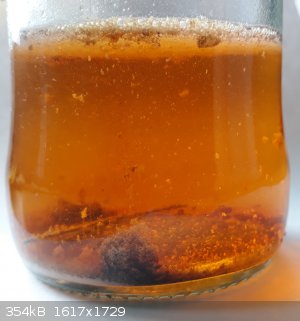
|
|
|
AJKOER
Radically Dubious
    
Posts: 3026
Registered: 7-5-2011
Member Is Offline
Mood: No Mood
|
|
After first one minute MW treatment
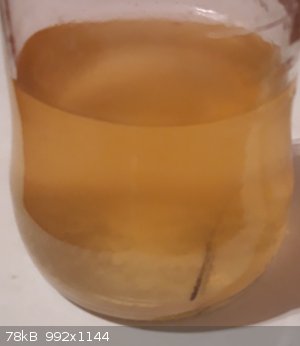
|
|
|
AJKOER
Radically Dubious
    
Posts: 3026
Registered: 7-5-2011
Member Is Offline
Mood: No Mood
|
|
Final 2 treatment solution
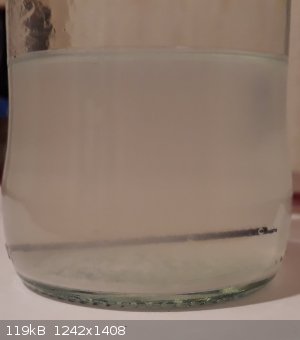
|
|
|
AJKOER
Radically Dubious
    
Posts: 3026
Registered: 7-5-2011
Member Is Offline
Mood: No Mood
|
|
These pictures relate to the mixing of CaCl2 (aq) (which displays some white undissolved salt) with a perfectly clear extract of my treated mix, which
was followed by a microwave treatment resulting in the calcium iodate white salt.
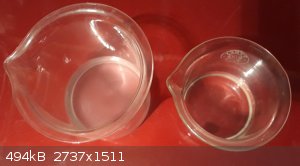
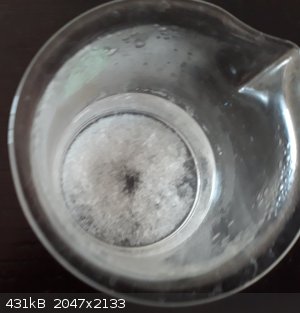
[Edited on 7-7-2019 by AJKOER]
|
|
|
AJKOER
Radically Dubious
    
Posts: 3026
Registered: 7-5-2011
Member Is Offline
Mood: No Mood
|
|
Results of the energetic Fe/Iodate test showing some residual I2 brown spots from a reaction with water vapor.
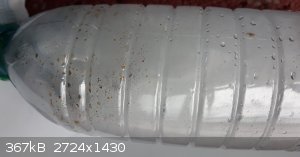
[Edited on 7-7-2019 by AJKOER]
|
|
|
AJKOER
Radically Dubious
    
Posts: 3026
Registered: 7-5-2011
Member Is Offline
Mood: No Mood
|
|
A side view of the calcium iodate salt in solution
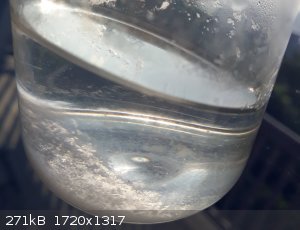
|
|
|
fusso
International Hazard
    
Posts: 1922
Registered: 23-6-2017
Location: 4 ∥ universes ahead of you
Member Is Offline
|
|
Why not filter out the organics before further steps (oxidation etc)?
|
|
|
AJKOER
Radically Dubious
    
Posts: 3026
Registered: 7-5-2011
Member Is Offline
Mood: No Mood
|
|
The actual reason is that I was performing an exploratory run (and actually was thinking elemental iodine, but accidentally derived iodate!).
I am not worried much about the presence of various organics as organo-iodine reactions (which should be minor in the current scheme) products are
apparently very volatile (escaping into the air), but be very careful to avoid fumes (read below).
In my prior experimenting with iodine pills, I used as an acid source lemon juice extract (as sold in stores) and a H2O2/Microwave/Carbon path. This
turned out to be a very bad idea as I created, with the apparent help of radicals, a lot of nasty organo-iodine compounds (fumes from a venting
solution touch my perspiring forehead and resulted in a numbing of my forehead as if I had pay a trip to the dentist office, and he injected my
forehead, instead of my tooth. After several washings the numbness faded but apparently some of the compound spread to my lower jaw area as a result
of the face washing, and then proceeded to further numb, some scary stuff.
Research comes up with terms like alkylating agent and a one word warning 'avoid'.
So for a safer preparation, perhaps removing the organics is advised, but likely difficult because the pills contain stearic acid to start a chemical
release of iodine on contact with water.
[Edited on 7-7-2019 by AJKOER]
|
|
|
AJKOER
Radically Dubious
    
Posts: 3026
Registered: 7-5-2011
Member Is Offline
Mood: No Mood
|
|
An advantageous aspect of this described prep for iodate from iodide is that when the I3- solution becomes visibly clear, possibly all (approaching
100%) of the available elemental iodine may be in the form of iodate!
Improvement would relate to the speed that this is accomplished.
In this regard, per this 2007 source, 'Generation of hydroxyl radical in aqueous solution by microwave energy using activated carbon as catalyst and
its potential in removal of persistent organic substances', by Xie Quan, et al, at https://www.sciencedirect.com/science/article/pii/S138111690... , one may be able to replace low surface area graphite rods here with other forms
of high area activated carbon (AC) to possibly more rapidly form the iodate (however, my prior warning that AC absorbs iodine remains valid, but this
may still allow some surface chemical oxidation of the iodine to iodate).
On the topic of AC preparation, I have recently explored using burnt food (as in carbonized toast, see https://www.sciencemadness.org/whisper/viewthread.php?tid=15... for comment and reference) as a form of activated carbon. Other examples, in the
literature, include the use of coconut shells as a superior source for AC (see https://pdfs.semanticscholar.org/ba8f/73d0b9f437e05ecb5a1645... ). Apparently, burnt vegetables in contact with air and food acids can convert
chlorine bleach to ClO3- (in place of IO3- here) and boom, as I noted previously on SM:
"Carbon produced by accidentally burning vegetables is also a source of radicals especially in a pan (of Al or Fe?) with boiling bleach. In fact,
there is a report in Bretherick on an explosion occurring by someone trying to clean a pot with burnt vegetables on boiling with NaOCl, and forgetting
it was on the stove! An accidentally revealed chlorate route!"
Link: http://www.sciencemadness.org/talk/viewthread.php?tid=151055...
------------------------------------------
"A good amateur scientist eats his vegetables, but a better one turns them into activated carbon"
[Edited on 8-7-2019 by AJKOER]
[Edited on 8-7-2019 by AJKOER]
|
|
|
|